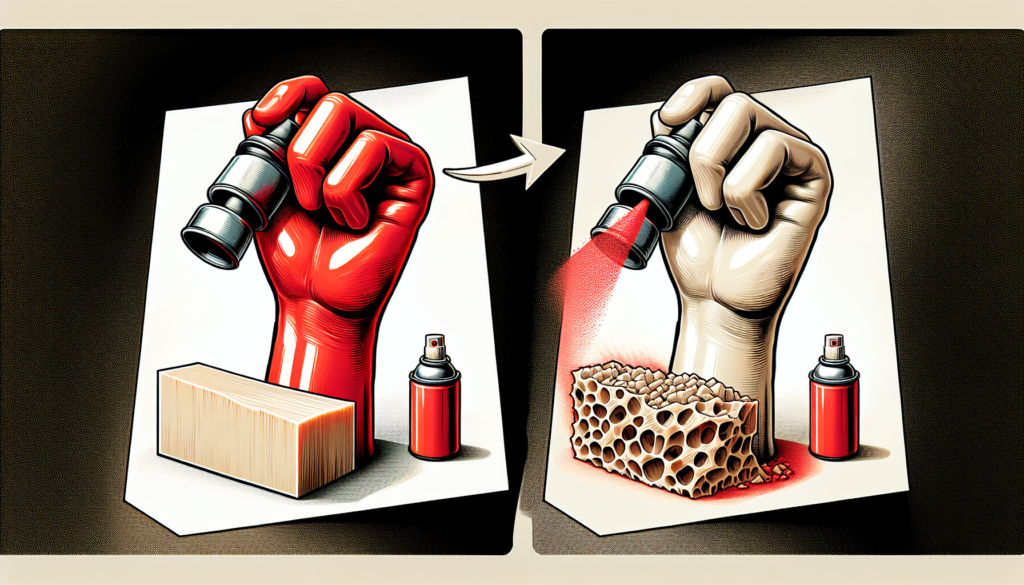Embarking on a new DIY project and wondering how to jazz up some ABS plastic items with spray paint? You’re on the right path! This article will serve as your friend and guide, illuminating you on the all-important techniques to expertly apply spray paint to ABS plastic. From the necessary prep work to the main painting process and tips for perfect finishing, you’ll find all your queries answered right here. So, gather up your supplies and get ready to learn something new today.

Choosing the Right Spray Paint
When you’re embarking on a project that involves spray painting ABS plastic, choosing the right spray paint is a crucial first step. The color and quality of the paint can dramatically impact the result of your work.
Understanding ABS Plastic
ABS (Acrylonitrile Butadiene Styrene) plastic is a thermoplastic polymer widely used due to its impressive strength, durability, and ability to withstand heat and cool temperatures. It’s found in many everyday items, such as kitchen appliances, toys, and automotive parts. The beauty of this plastic is that while it’s tough, it’s also easily workable and paintable.
Types of Spray Paint Suitable for ABS Plastic
When it comes to spray painting ABS plastic, you have a few options to choose from. The most suitable types of spray paint are acrylic and enamel paints. Acrylic spray paint is a popular choice for its fast drying times and glossy finish. Enamel paints, on the other hand, are also effective for ABS plastic due to their durability and resistance to chipping.
Considerations for Color and Finish
When it comes to color and finish, you may wish to consider the practical implications of your choices. Darker colors or semi-gloss finishes often do a better job of disguising minor flaws on the surface of the ABS plastic. On the other hand, lighter colors and high-gloss finishes may give your project a crisp, clean appearance.
Preparing the ABS Plastic Surface
Before you can begin spray painting the ABS plastic, it’s essential to prepare the surface to ensure a smooth, even finish. This helps the paint adhere to the surface better and results in a professional-looking finish.
Clean the Surface
Start by cleaning the surface thoroughly with a mild detergent solution and a soft cloth to remove any dust, grease, or grime. Be sure to rinse the surface well with warm water, then use a dry cloth to wipe it dry.
Sand the Surface
Following cleaning, sand the surface lightly using fine-grit sandpaper. This step is vital as it provides a rough texture on the ABS plastic surface for the primer and paint to adhere to.
Fill and Smooth Imperfections
Use a filler to repair any dents, scratches, or other surface imperfections on the ABS plastic. After applying the filler, allow it to dry, then sand the surface again until it’s smooth.
Apply Primer
Before applying paint, it’s advisable to apply a coat of plastic primer. This step aids in providing better paint adhesion, increases paint durability, and can also provide additional protection to the ABS plastic.
Spraying Techniques
Now that your ABS plastic is prepared, it’s time to move onto applying the spray paint. Here are some expert techniques to get you started.
Choosing the Right Spray Nozzle
The spray nozzle you choose can significantly impact the outcome. A nozzle with a wider angle will distribute paint more evenly and prevent streaks.
Practice on Scrap Material
Before you start painting your project, it’s a good idea to practice on a scrap piece of ABS plastic. This will help you gauge the spray nozzle’s spread and understand how quickly the paint dries.
Optimal Spray Distance
As a general rule, the best distance at which to spray paint is approximately 10 to 12 inches from the surface. This allows for a comprehensive, even distribution of the paint.
Avoid Overlapping or Excessive Coating
Take care not to overlap strokes too much, as this can lead to an uneven coat or drips. Instead, aim for numerous light coats, allowing each to dry fully before applying the next.
Applying Multiple Thin Coats
When you apply several thin coats of paint, it aids in building up a sturdy, smooth finish. Always allow ample drying time between each one to avoid a sloppy or streaky finish.
Execution
Having taken the time to prepare your ABS plastic surface and practice your spraying techniques, you’re now ready to execute your project!
Setup a Proper Working Area
Set up a clean, well-ventilated working area. Ensure you lay down enough drop cloths or newspapers to protect the surrounding area from overspray. Also, it’s ideal to choose a place with plenty of light so you can see your work clearly.
Wear Protective Gear
When dealing with spray paint, it’s essential to wear appropriate protective gear, including goggles, gloves, and a mask, to avoid inhaling harmful paint fumes.
Apply the Base Coat
Spray your base coat of paint onto the ABS plastic. Use even, sweeping motions to prevent the collection of paint in any one spot.
Allow Drying Time
After you’ve applied your base coat, allow it to dry as per the manufacturer’s instructions. It’s important to be patient during this time as rushing could ruin your perfect finish.
Apply Additional Coats as Needed
Once your base coat is dry, you can apply additional coats of paint until you’re satisfied with the coverage. Always allow each layer to dry thoroughly before applying the next.
Final Touches and Drying
After applying the final coat, leave the piece to dry completely. Once dry, examine the piece carefully for any touch-ups you may need to make, then allow for a final drying period.

Dealing with Common Issues
Even the most experienced painter can occasionally encounter issues when spray painting ABS plastic. Here’s how to tackle some of the most common problems successfully.
Bubbling or Blistering
This issue often arises due to painting over a surface that has not been adequately cleaned or prepared. If you notice bubbling or blistering, wait for the paint to dry, then sand the area lightly and repaint.
Uneven Coverage
Uneven coverage usually results from spraying too close to the surface, spraying in an uneven motion or overlapping too much. To correct this, let the paint dry fully, sand lightly, and apply another coat of paint.
Drips or Runs
If you’ve noticed drips or paint runs on your ABS plastic, it generally means you’ve applied too much paint. You can correct this by allowing them to dry, sanding the surface smooth, and repainting.
Paint Not Adhering
If the paint isn’t sticking to the ABS plastic, it likely means the surface wasn’t sufficiently roughened up before painting. In this case, you’ll need to sand the surface with fine-grit sandpaper and reapplied the primer.
Fixing Mistakes
Even if you make a mistake, don’t despair! Most errors can be fixed by allowing the paint to dry, lightly sanding the area, and applying a new coat of paint.
Aftercare and Maintenance
After you’ve successfully spray painted your ABS plastic, it’s essential to know how to maintain and care for it to preserve its new look.
Proper Curing Time
After the final coat, give the paint ample time to cure fully. This might take a few days, but it’s well worth the wait, as it ensures the paint’s durability and long-lasting finish.
Avoid Harsh Chemicals
After painting, avoid using harsh chemicals or abrasive cleaners on your ABS plastic. These could damage the paint finish or cause unnecessary scratches.
Regular Cleaning and Maintenance
Regular care and maintenance of your painted ABS plastic can extend its life and keep it looking fresh. Use warm water and mild soap to clean. Avoid using anything abrasive that could scratch the coat, and be sure to dry it thoroughly.
Tips and Tricks
Here are some useful tips and tricks that can enhance the overall result of your spray-painting project.
Use a Guide Coat for Surface Identification
A guide coat helps identify low spots or imperfections on the surface that can then be filled for a smoother finish. Apply a light spray paint coat over your primer before applying your color coats.
Temperature and Humidity Considerations
For an optimal finish, work in a cool, dry environment. High temperatures can cause the paint to dry too rapidly while high humidity can affect the paint’s overall drying time and finish.
Gradual Light Sanding for Smooth Finish
After each coat of paint, use a high grit sandpaper (1000 grit or above) to lightly sand the surface. This results in a smoother finish and helps the next coat adhere better.
Experiment with Different Techniques
There’s no one-size-fits-all technique for spray painting ABS plastic. Feel free to experiment with different spraying actions — circular, side-to-side, etc. — to find what works best for you.
Customization Options
Don’t just stick with a single color! The sky is the limit when it comes to customization. Experiment with different color combinations, finishes, or even add decals for a fun, personalized look.
Safety Precautions
Safety should be your priority when using spray paint. Here are some safety precautions for you to keep in mind.
Adequate Ventilation
To minimize inhalation of toxic fumes, always paint in a well-ventilated area or outdoors.
Use Respiratory Protection
Always wear a mask or respiration device when working with spray paint to prevent inhalation of aerosol droplets and particles.
Avoid Open Flames and Smoking
Spray paints are flammable, so it’s important to avoid any open flames or smoking while you’re working.
Avoid Skin Contact
Spray paint can irritate the skin and be challenging to remove. Wearing gloves can help prevent any paint from getting onto your skin.
Proper Disposal of Paint Cans
After the completion of your project, dispose of empty paint cans properly according to local disposal regulations.
Alternative Methods
Apart from spray painting, other methods can prove to be just as effective, depending on the size and scope of your project.
Brushing Techniques
Brush painting can be an excellent alternative for smaller projects or for surfaces with intricate details that a spray may not reach effectively.
Dip Coating
Dip coating involves dipping the plastic into a tub of paint and allowing it to dry. This technique ensures an even coat but might not be suited for larger, cumbersome pieces.
Airbrushing
Airbrushing uses a smaller, precision paint sprayer, perfect for highly detailed work on smaller pieces of ABS plastic.
Electrostatic Painting
Electrostatic painting is a technique that creates an even coat of paint across the surface by utilizing an electrical charge, highly suited for industrial applications.
Considerations for Specific ABS Plastic Applications
Let’s round off with some specific considerations for different ABS plastic applications.
Painting Automotive ABS Parts
Automotive parts require a special kind of paint that can withstand changing weather conditions and continuous wear and tear. It’s recommended to use enamel spray paint for these types of projects, as it’s more durable and resistant to wear.
Spray Painting ABS Models and Prototypes
When it comes to spray painting models, figures, or prototypes made from ABS plastic, patience and attention to detail are key. Opt for low-pressure cans for better control over the amount of paint dispensed.
Decorative Painting on ABS Plastics
For decorative purposes, you can experiment with different types of paint, finishes, and colors for a more personalized touch. Just always remember to prepare the surface properly to ensure a professional-looking result.
And there you have it! By following these steps, tips, and guidelines, you’re well on your way to successfully spray painting ABS plastic. So, gear up and let those creative juices flow. Happy painting!



